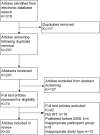The use of wearable technology to measure and support abilities, disabilities and functional skills in autistic youth: a scoping review
- PMID: 33520778
- PMCID: PMC7685500
- DOI: 10.21307/sjcapp-2020-006
The use of wearable technology to measure and support abilities, disabilities and functional skills in autistic youth: a scoping review
Abstract
Background: Wearable technology (WT) to measure and support social and non-social functioning in Autism Spectrum Disorder (ASD) has been a growing interest of researchers over the past decade. There is however limited understanding of the WTs currently available for autistic individuals, and how they measure functioning in this population.
Objective: This scoping review explored the use of WTs for measuring and supporting abilities, disabilities and functional skills in autistic youth.
Method: Four electronic databases were searched to identify literature investigating the use of WT in autistic youth, resulting in a total of 33 studies being reviewed. Descriptive and content analysis was conducted, with studies subsequently mapped to the ASD International Classification of Functioning, Disability and Health Core-sets and the ICF Child and Youth Version (ICF-CY).
Results: Studies were predominately pilot studies for novel devices. WTs measured a range of physiological and behavioural functions to objectively measure stereotypical motor movements, social function, communication, and emotion regulation in autistic youth in the context of a range of environments and activities.
Conclusions: While this review raises promising prospects for the use of WTs for autistic youth, the current evidence is limited and requires further investigation.
Keywords: Autism Spectrum Disorder; ICF; physiology; sensors; wearable devices.
© 2020 Authors.
Conflict of interest statement
Conflicts of interest Dr. Bölte reports personal fees from Medice, Roche, Prima Psychiatry, Hogrefe, grants from Swedish Research Council, ALF, Hjärnfonden, Clas Groschinsky, Promobilia, Region Stockholm, FORTE, outside this work. All other authors report no conflicts of interest.
Similar articles
-
International Classification of Functioning, Disability and Health Core Sets for cerebral palsy, autism spectrum disorder, and attention-deficit-hyperactivity disorder.Dev Med Child Neurol. 2018 Sep;60(9):933-941. doi: 10.1111/dmcn.13922. Epub 2018 May 30. Dev Med Child Neurol. 2018. PMID: 29845609
-
Classification of functioning and impairment: the development of ICF core sets for autism spectrum disorder.Autism Res. 2014 Feb;7(1):167-72. doi: 10.1002/aur.1335. Epub 2013 Oct 3. Autism Res. 2014. PMID: 24124074
-
The development of the International Classification of Functioning, Disability and Health for Child and Youth (ICF-CY) Core Sets: a systematic review.Disabil Rehabil. 2023 Nov;45(23):3951-3960. doi: 10.1080/09638288.2022.2136269. Epub 2022 Oct 22. Disabil Rehabil. 2023. PMID: 36271731
-
Comparative content review of children's participation measures using the International Classification of Functioning, Disability and Health-Children and Youth.Arch Phys Med Rehabil. 2014 Jan;95(1):141-52. doi: 10.1016/j.apmr.2013.06.027. Epub 2013 Jul 12. Arch Phys Med Rehabil. 2014. PMID: 23851418 Review.
-
Functioning and disability in autism spectrum disorder: A worldwide survey of experts.Autism Res. 2016 Sep;9(9):959-69. doi: 10.1002/aur.1592. Epub 2016 Jan 8. Autism Res. 2016. PMID: 26749373 Free PMC article.
Cited by
-
The Current View on the Paradox of Pain in Autism Spectrum Disorders.Front Psychiatry. 2022 Jul 22;13:910824. doi: 10.3389/fpsyt.2022.910824. eCollection 2022. Front Psychiatry. 2022. PMID: 35935443 Free PMC article. Review.
-
Association of Demographic and Socioeconomic Indicators With the Use of Wearable Devices Among Children.JAMA Netw Open. 2023 Mar 1;6(3):e235681. doi: 10.1001/jamanetworkopen.2023.5681. JAMA Netw Open. 2023. PMID: 36995714 Free PMC article.
-
Challenging Behaviors in Children with Nonverbal Autism: A Questionnaire to Guide the Design of a Wearable Device for Biomarker Recording.Sensors (Basel). 2025 Mar 23;25(7):2009. doi: 10.3390/s25072009. Sensors (Basel). 2025. PMID: 40218521 Free PMC article.
-
Application of the international classification of functioning, disability, and health in autism and attention-deficit hyperactivity disorder: A scoping review.Autism. 2025 Feb;29(2):310-328. doi: 10.1177/13623613241272044. Epub 2024 Aug 25. Autism. 2025. PMID: 39183470 Free PMC article.
-
The Stress Phenotyping Framework: A multidisciplinary biobehavioral approach for assessing and therapeutically targeting maladaptive stress physiology.Stress. 2024 Jan;27(1):2327333. doi: 10.1080/10253890.2024.2327333. Epub 2024 May 6. Stress. 2024. PMID: 38711299 Free PMC article. Review.
References
-
- Wright R, Keith L. Wearable technology: If the tech fits, wear it. J Electr Resources Med Libr 2014;11(4):204-16.
-
- Bonato P. Advances in wearable technology for rehabilitation. Stud Health Technol Inform 2009;145:145-59. - PubMed
-
- Fletcher R, Poh M, Eydgahi H. Wearable sensors: Opportunities and challenges for low-cost health care. 2010 Annual International Conference of the IEEE Engineering in Medicine and Biology; Buenos Aires, Argentina IEEE; 2010. p. 1763-6. - PubMed
Publication types
LinkOut - more resources
Full Text Sources
Medical
Miscellaneous

